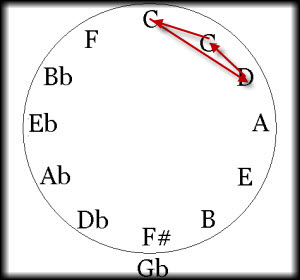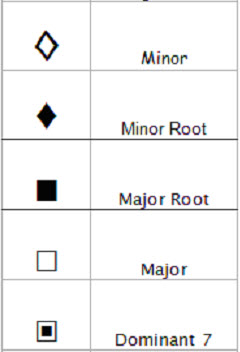A new approach to Classical harmony with SeeChord
The “rules” of harmony have consistently provided some of the greatest teaching and learning challenges in music. Even simple chord progressions can become dauntingly complex with the addition of a few extra notes, a different chord or a change of key.
Notating chords as text or Roman numerals can give us some insight into the patterns that are inherent in all music, but quickly become cumbersome and often more confusing than the written music itself.
SeeChord is trying to change all that. Using simple visual patterns to represent the harmony of a piece, the user can quickly identify certain important features of a piece of music that stand out as being conventional, or that break the “rules” of harmony.
A SeeChord chart is basically a graph, the root notes of the chords are laid out on the y-axis in fifths, time in bars and beats on the x-axis. An empty bar of a chart looks like this:

So, why are the chords laid out in fifths on the x-axis? Well, it comes down to the fact that a fifth (C-G or G-D) is probably the most important interval there is in music. Mathematically, a G resonates at 1.5 the frequency of the C below it. Our are are finely tuned to pick up these relationships and so we hear a C and a G as “consonant”. Detune the G slightly and our ears pick up a nasty “dissonance” as this relationship is warped.
Likewise, a C resonates at 1.5 the frequency of the F below it, and so F and G are the most closely related notes to C.
A circle of fifths has traditionally been used to illustrate the movement of harmony. Here, the simple progression C-dm-G-C can be seen represented with arrows:
Problems quickly arise with longer sequences of chords as the circle becomes cluttered with lines. We certainly could not represent the harmony of an entire song or piece as the result would be unintelligible! On a SeeChord chart, the sequence looks like this.
Different symbols have been used to represent different types of chords as below:
The symbols have been joined up with simple lines to provide a little more visual clarity. Now we can easily extend this sequence for as long as we like. Let us look at the first 11 bars of this piece, which is The First Prelude from the first book of The Well Tempered Clavier by J.S.Bach.
[seeChordViewer src=”/content/Application/Interpretation/interpretation1-viewer”]
Now we can start to build up a picture of how the harmony is moving in this piece without getting bogged down in chord symbols. Let us do some analysis of this simple and beautiful chord sequence. You can see a similar analysis online and hear the music being played at http://www.youtube.com/watch?v=JE5penT5_e0
This piece is in the key of C major and as we would expect, C is the first chord (the chord is split into an arpeggiated pattern in the actual music). After a small journey through dm and G7, we return to C. This is a way of establishing the tonic which gives us the sense that we really are at home in C.

Next, we can see a pattern that occurs in almost every piece of music at some point; a sequence of falling fifths. SeeChord highlights this pattern very well as the graph literally falls down through the chords.

Finally, at the end of the phrase, we can see a temporary modulation into the key of G. It is only temporary as soon afterwards, the music returns to C again.

It is important to notice how this modulation or key change has been achieved. The new key is established with a perfect cadence D7-G. This is the most convincing way of arriving at a new key. However, this cadence is really three chords, am-D7-G. The am chord strengthens this key change even more. This is often referred to as a ii-V-I, but is really easy to see on the chart.
This kind of analysis is made simple by being able to see entire pieces on a SeeChord chart. Modulations, recurring themes, harmonic sequences and much more can be explored just by pointing out visual patters that leap from the page.
However complex the music, SeeChord can give insight into its structure. Let’s look at this excerpt from Prokofiev’s Classical symphony.
[seeChordViewer src=”/content/Application/Cadences/cadences10-viewer”]
This example starts with a perfect cadence in the tonic of D.
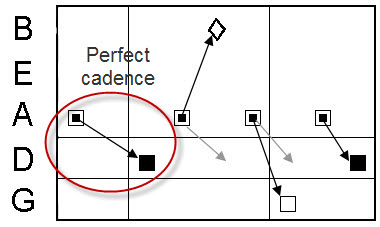
Then we have two interrupted cadences. These cadences occur when we expect the music to fall to the tonic as in the perfect cadence, but it goes somewhere else instead. In this example, the first goes to bmin, the second to G.
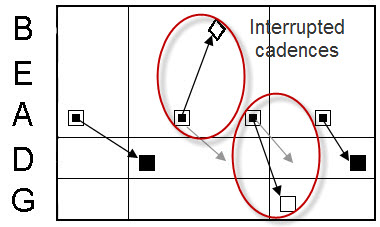
The grey arrows indicate where the ear expect the music to go. Finally, we are treated to the same perfect cadence that this section began with, giving a very satisfying sense of completion.
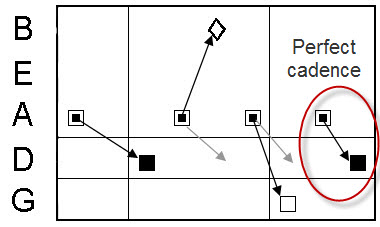
If we were to write out this passage in conventional chord notation, it would look like this:
A7-D, A7-bmin, A7-G, A7-D.
Or in Roman Numerals:
V7-I, V7-vi, V7-IV, V7-I.
The SeeChord chart really brings these to life. Now we see the cadence structure of this passage and can discuss, teach or simply listen with a more educated ear to the beauty of Prokofiev’s writing.
SeeChord is already being used in Secondary schools to help students enter more meaningfully into the complex world of harmony. Song writers are using it to develop more interesting progressions, or to emulate their heroes. Composers can really construct beautiful harmonic sequences and negotiate tricky modulations by writing with a SeeChord chart close to hand.
If you have any comments relating to this article, please send us an email. Details are on the contact page
